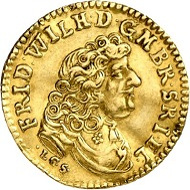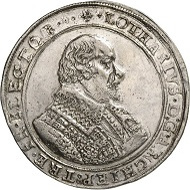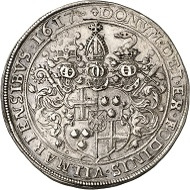31-10-2016 – 01-01-1970
Auction 2: The Preussag Collection – Part II
1.6 million pounds for the second part of the Preussag Collection
On 1 November 2016 London Coin Galleries, in cooperation with Künker, Osnabrück sold the second part of the Preussag Collection, comprising mining coins and medals, in London. The first part consisting of 217 lösers was auctioned off in 2015 and achieved 6.4 million pounds. Attracting wide interest among the audience, the second part also sold very well, with the end result adding up to two and a half times the estimate, starting from 630,000 pounds and arriving at 1.6 million pounds, roughly equaling 1.8 million euros. Altogether, the Preussag Collection realized more than 8 million pounds.
Lot 1017: Brandenburg. Friedrich Wilhelm, 1640-1688. Ducat 1683, LCS, Berlin. “Guinea-Dukat”. Very rare. Very fine. Estimate: 2,500 GBP. Hammer price: 8,500 GBP.
Collectors of pre-1871 Germany were looking forward to an interesting auction sale, for the majority of strikings on offer came from there. With 260 lots, most of the coins stemmed from Brunswick, although Henneberg, Hesse, Hohnstein, Stollberg, and many other territories were also represented by a rich selection.
Lot 1152: Brunswick-Calenberg. Johann Friedrich, 1665-1679. Double reichstaler 1678, Clausthal, from the yield from the Herzog Johann Friedrich Mine. Thick taler. Extremely rare. Very fine to extremely fine. Estimate: 6,000 GBP. Hammer price: 13,000 GBP.
The second part of the Preussag Collection contained some very few lösers as well. They all obtained good prices, particularly when featuring magnificent mining scenes – as, for instance, the coins of Johann Friedrich of Brunswick-Calenberg. Showing the crowned Saxon Steed above a detailed scenery with machinery above and below ground, as a horse mill, waterworks and flatrod systems, the sextuple löser of 6 reichstalers from 1677 rose from 3,000 pounds to 12,000 pounds (= 13,400 euros). Depicting galleries and tunnels below ground, a double reichtstaler 1678 exceeded its estimate of 6,000 pounds by far when it achieved a hammer price of 13,000 pounds (= 14,500 euros).
Lot 1111: Brunswick-Wolfenbüttel. Karl Wilhelm Ferdinand, 1780-1806. Ducat 1783, Brunswick. “Harzgold Ducat”. Very rare. Extremely fine. Estimate: 1,250 GBP. Hammer price: 3,400 GBP.
Minted from the gold admixture to the silver of the Rammelsberg Mines, the rare Harzgold Ducats fetched excellent prices. The 1783 ducat of Karl Wilhelm Ferdinand of Brunswick-Wolfenbüttel received the final bid only at three times its estimate, at 3,400 GBP (= 3,800 euros).
Lot 1277: Hanover. Gold medal 1830, by R.V. Jeuffroy, on the breach of the Treaty of Amiens and the occupation of Hanover by Consul Napoleon. Extremely rare. In gold probably unique. Extremely fine to FDC. Estimate: 5,000 GBP. Hammer price: 30,000 GBP.
As the connoisseurs already anticipated, the most expensive item of this auction sale was a gold medal minted by Napoleon in 1830 on the occupation of Hanover. What made this lot special was not the fact that famous Vivant Denon had been responsible for both the design and its execution. No, much more impressive was that, made of gold, this medal was unique and, on top of that, from the possession of the Bonaparte family. For this attraction, the new owner gladly paid 30,000 pounds plus premium (= 33,500 euros).
Lot 1315: Henneberg. 1/2 reichstaler 1696, Ilmenau. Thick taler, minted from the dies of the 1/4 reichstaler. Yield from the Ilmenau Mines. Extremely rare, probably unique. Almost extremely fine. Estimate: 3,000 GBP. Hammer price: 11,000 GBP.
Equally unique, a thick piece of the 1/2 Henneberg reichstaler dating from 1696, minted at Ilmenau, realized 11,000 pounds (= 12,300 euros) on a pre-sale estimate of 3,000 pounds. This is one of many surprises this auction held in store.
Lot 1426: Nassau-Weilburg. Karl August, 1719-1753. Reichstaler 1752, Weilburg. Yield from the Mehlbach Mines. Very rare. Extremely fine / FDC. Estimate: 2,500 GBP. Hammer price: 8,000 GBP.
Commemorating the 1717 Reformation jubilee, a silver medal whose reverse featured an elaborate depiction of the city of Goslar by Christian Wermuth, crossed the auction block for almost ten times its appraisal when it achieved 4,600 pounds (= 5,100 euros / estimate: 500 GBP), whereas a reichstaler of Karl August of Nassau-Weilburg, struck in Weilburg in 1752 from the yield from the Mehlbach Mines, had been estimated at 2,500 GBP but finally achieved 8,000 pounds (= 8,900 euros) which was more than three times the pre-sale price.
Lot 1464: Saxony, Electorate. Johann Georg III, 1680-1691. Silver medallion of 8 reichstalers 1690, by M.H. Omeis, yield from the St Anna and Altväter Mines. Very rare. Extremely fine. Estimate: 2,500 GBP. Hammer price: 9,000 GBP.
Probably one of the most attractive mining coins ever is a silver medallion of 8 reichstalers from 1690, made by M.H. Omeis, providing superb insights into how mining worked at the St Anna and Altväter Mines above and below ground. On an appraisal of 2,500 pounds, the specimen rose to 9,000 pounds (= 10,000 euros), with the bronze version being expensive, too. Made of gilded bronze, it cost 2,800 pounds while the bronze version was sold for 3,800 pounds (= 3,100 euros; 4,200 euros).
Lot 1583: Trier. Lothar von Metternich, 1599-1623. Reichstaler 1617, Coblenz. Yield from the Vilmar Mines. Extremely rare. Almost extremely fine. Estimate: 12,500 GBP. Hammer price: 17,000 GBP.
The second most expensive striking from the pre-1871 Germany department came from Trier. The rare reichstaler of Lothar von Metternich had been minted in Coblenz in 1617, from the yield from the Vilmar Mines. Graded almost extremely fine, the coin was sold for 17,000 pounds (= 19,000 euros), on an estimate amounting to 12,000 pounds.
Lot 1591. Württemberg. Eberhard Ludwig, 1693-1733. Reichstaler 1728, Stuttgart. Yield from the Dreikönigstern Mine. Very rare. Very fine. Estimate: 300 GBP. Hammer price: 6,000 GBP.
Two great surprises were to be witnessed when a lot skyrocketed to twenty times its estimate. Firstly, the result achieved by a reichstaler of Eberhard Ludwig of Württemberg, minted in Stuttgart in 1728 and made of silver yielded from the Dreikönigstern Mine. Graded very fine and exhibiting a punch reading FS, the specimen started at modest 300 pounds, only to end at a hammer price of 6,000 pounds (= 6,700 euros).
Lot 1596. HRE. Cast silver medal 1533 of Count Nicola III of Zrinski. Minted from silver yielded from the Zrinski mountains. Extremely rare. Very fine, cast of the time. Estimate: 500 GBP. Hammer price: 10,000 GBP.
The second surprise was a cast silver medal from 1533, commissioned by Count Nicola III of Zrinski. On the obverse, it depicts King David playing the lyre, on the reverse a coat of arms with the Latin motto “Whatever you do, may you do it prudently and look to the result”. Having been estimated at nothing more than 500 pounds, the medal’s flight only came to an end at nearly 10,000 pounds (= 11,000 euros).
Lot 1608. HRE. Charles VI, 1711-1740. 2 ducats 1725, Prague. Yield from the mines at Eule (Jélové). Extremely rare. Extremely fine. Estimate: 10,000 GBP. Hammer price: 26,000 GBP.
10,000 pounds had been the estimate of an extremely rare double ducat of emperor Charles VI, minted in Prague in 1725, from the yield of the mines located at Eule (Jélové). The coin became the second most expensive item of the auction sale, obtaining a hammer price of 26,000 pounds (= 29,000 euros).
Lot 1637: Austrian Mediatized Houses. Wilhelm, 1581-1592. Ducat 1587, Reichenstein. Yield from the Reichenstein Mines. Very rare. Very fine. Estimate: 1,500 GBP. Hammer price: 9,000 GBP.
A seemingly inconspicuous ducat – very fine, bent – of Wilhelm von Rosenberg from 1587, minted in Reichenstein was auctioned off for 9,000 pounds (= 10,000 euros / estimate: 1,500 GBP), a gold guldiner of Vladislaus II of Hungary, struck in Nagybanya around 1500 and also graded “only” very fine to extremely fine, for 2,600 pounds (= 2,900 euros / estimate: 300 GBP).
Lot 1747: Bolivia. Carlos III, 1665-1700. 8 reales 1687, Potosi. Yield from the mines at Potosi. Very rare. Holed, very fine. Estimate: 500 GBP. Hammer price: 8,000 GBP.
Let us close this review with a 1678 8 reales piece from Potosi, holed and “only” very fine, but very, very rare. Fully centered, the specimen started at 500 pounds, only to be sold for a hammer price of 8,000 pounds (= 9,000 euros).
To give you an idea of how much sought-after some multiple lots can be: 11 sometimes extremely comprehensive multiple lots concluded the auction. Their estimates had added up to 115,500 pounds. The total hammer price was more than three times that sum, 391,300 pounds (= 436,400 euros).
All results can be viewed online at Künker.





























